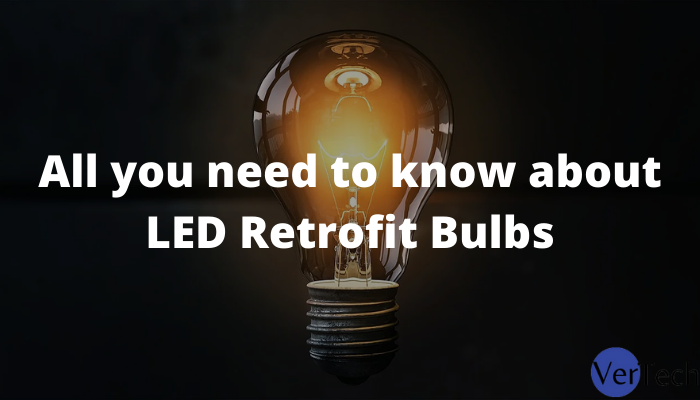Industrial
All You Need To Know About LED Retrofit Bulbs

Have you thought about installing LED lights in your business or home? Not sure how to do it? You’re in the right place. Here’s a primer on how to get your place up to date with new lighting with the help of LED retrofit bulb suppliers
About LED retrofits:
Adding something new to your facility means that you’re making changes to the building that it didn’t have before or was not part of when it was built. This could be new technology, a component, or an accessory. What we call “retrofit” is very similar to what we say when talking about “conversion.” There are a lot of LED lighting retrofits going on today, so that’s what most of them are.
LED retrofits make sense because they save money:
LED lights are taking over the technology of traditional lighting in many lighting applications. They can be used for lighting inside and outside and small lighting in electrical and mechanical uses. Make use of services from the best LED retrofit bulb suppliers.
Why should I do an LED retrofit, and what’s their advantage?
LED retrofit benefits you in three ways:
- Enhances Energy-saving
- Cuts operating costs, including maintenance costs that come up again and again (both labor and parts)
- Offers better lighting quality.
There are also unique opportunities for business and finance options for people who want an LED conversion or retrofitting Examples: Working with ESCOs (Energy Savings Companies) or getting rebates from the federal or state government are two ways to help.
What are the main things to think about during LED retrofitting?
Many types of lighting don’t work the same way LEDs do. You’ll need to know these things if you want to change the lights in your buildings to LED (retrofitting).
- It’s not the same thing to say “fixtures” and “lamps.” If you want to keep your old fixtures, you may have to narrow down the number of bulbs that will work with them. There will be a lot to choose from if you want to replace both the light and the fixture (housing) at once. Most LEDs are built to work with standard light bulbs.
- People usually don’t use dimming hardware for LED lights because it doesn’t work with conventional lights. With the new bulbs, LED dimmers will be necessary.
There are many benefits to retrofitting your home, such as:
Retrofit bulbs use LED technology in a new way that has a lot of good things. It saves a lot of energy and lasts for up to 100,000 hours. Besides these general advantages, retrofits have other advantages:
- It can be used with existing lights.
- There is no installation work to do.
- The consumer can do the replacement.
There are many ways to retrofit existing lights so that old incandescent and halogen bulbs can be changed out. However, technology has changed so much that old-fashioned gadgets can no longer be used. This isn’t the case with LED retrofits: the existing lights stay in place, and only the light source is changed.
Also, there aren’t any changes to the electrical system that needs to be made. So, the retrofits can usually be put in by the person who owns the light. And if there is a problem with the retrofit bulb, even though it has a long life, it can be easily replaced.
Can we Use LED Light Bulbs in Existing Light Fixtures?
The wattage of any lightbulb is, of course, the most important thing to consider when making a purchase. Put a high-watt bulb into a fixture that doesn’t have enough wattage, and you’ll get a weird effect. The light may be dim, it may be shorting out, or it may simply not be turning on at all. This can be found in many kinds of bulbs.
At least the minimum wattage specified for LED bulbs can be found in any light fixture, so long as it has enough power to operate. However, LED bulbs’ high efficiency means that this number is frequently low. Some LED bulbs are even capable of withstanding low or high power levels. Except for the halogen lights, they all use the same filaments.
Lumens are the primary source of variation. LEDs are susceptible to voltage fluctuations, dramatically affecting the quantity of light they produce. This is because their power requirements are far lower than those of most other types of lightbulbs.
As a result, LED bulbs have built-in restrictions that prevent them from releasing excessive amounts of light or bursting into flames when given more than they require. As a general rule of thumb, you can use these bulbs in any fixture that previously housed an incandescent or halogen bulb.
Conclusion:
LED retrofit illuminants to make it easy to replace old lamps with new LED technology. When retrofitting, pay attention to the size of the new lights because some of them are much bigger than the old ones. Also, if you want to change the brightness, the retrofit lamp can be dimmed.

-
Blog1 year ago
MyCSULB: Login to CSULB Student and Employee Portal – MyCSULB 2023
-
Android App3 years ago
Cqatest App What is It
-
Android1 year ago
What Is content://com.android.browser.home/ All About in 2023? Set Up content com android browser home
-
Software2 years ago
A Guide For Better Cybersecurity & Data Protection For Your Devices
-
Latest News2 years ago
Soap2day Similar Sites And Alternatives To Watch Free Movies
-
Android2 years ago
What is OMACP And How To Remove It? Easy Guide OMACP 2022
-
Android3 years ago
What is org.codeaurora.snapcam?
-
Business2 years ago
Know Your Business (KYB) Process – Critical Component For Partnerships




















